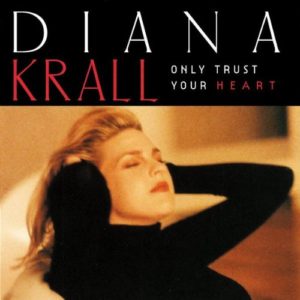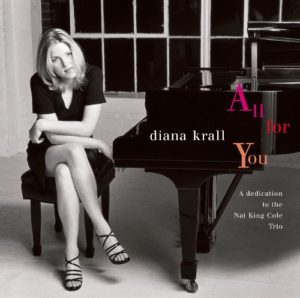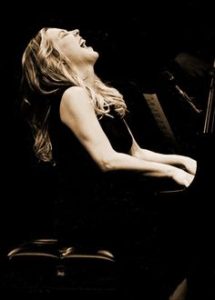I started writing newspaper and magazine profiles, mostly of musicians, some thirty-odd years ago. I only gave it up when my duties as a peripatetic drama critic grew too demanding. It wouldn’t be quite right to say that I regret having done so—I’ve always known that you can’t do everything you’d like to do—but I did derive an enormous amount of pleasure from meeting and writing about artists whom I admired, not a few of whom became good friends.
 Some of my profiles changed the lives of their subjects for the better, none more so than “A Soulful Star in the Making,” which appeared in The Wall Street Journal on June 7, 1995. The occasion was the release of Only Trust Your Heart, Diana Krall’s first major-label album, which had come out in February but had yet to attract any attention. I’d read a short feature about Diana in a jazz magazine, got curious, picked up a copy of the album, and listened to the first track, a cover version of Louis Jordan’s “Is You Is or Is You Ain’t My Baby?” I was so struck by what I heard that I called up my editor at the Journal and told him that I wanted to write a piece about an unknown Canadian singer-pianist. He gave me the green light, and a few days later I went down to Philadelphia to hear Diana perform at a now-defunct nightclub called Zanzibar Blue. She dropped by my Upper West Side apartment the following week to be interviewed. We chatted for an hour or so, and my piece, the first one about her to appear in a national publication aimed at a mainstream audience, came out not long after that.
Some of my profiles changed the lives of their subjects for the better, none more so than “A Soulful Star in the Making,” which appeared in The Wall Street Journal on June 7, 1995. The occasion was the release of Only Trust Your Heart, Diana Krall’s first major-label album, which had come out in February but had yet to attract any attention. I’d read a short feature about Diana in a jazz magazine, got curious, picked up a copy of the album, and listened to the first track, a cover version of Louis Jordan’s “Is You Is or Is You Ain’t My Baby?” I was so struck by what I heard that I called up my editor at the Journal and told him that I wanted to write a piece about an unknown Canadian singer-pianist. He gave me the green light, and a few days later I went down to Philadelphia to hear Diana perform at a now-defunct nightclub called Zanzibar Blue. She dropped by my Upper West Side apartment the following week to be interviewed. We chatted for an hour or so, and my piece, the first one about her to appear in a national publication aimed at a mainstream audience, came out not long after that.
Only Trust Your Heart charted a week after my profile was published, and Diana’s second album for Impulse, All for You: A Dedication to the Nat King Cole Trio, sold even better when it came out the following January. In August of 1997 she was booked into the late, lamented Oak Room of the Algonquin Hotel, then the most prestigious cabaret in New York. She received a rave review from Stephen Holden of the New York Times:
Vocal understatement is so unusual in a pop-jazz world where the majority of singers mistake volume and pyrotechnic display for virtuosity that one is almost inclined not to trust one’s ears on the rare occasions one encounters it. But understatement and subtlety are precisely what mark Diana Krall, the popular singer and pianist from British Columbia, as one of the most quietly expressive jazz singers of her generation.
The rest is history: she subsequently became, and has since remained, the most successful jazz singer of our time.
Twenty years after we met, Diana sent me an e-mail thanking me for writing about her in the Journal. “Of all the many pieces I’ve written through the years, I think I might just be proudest of that one,” I replied. “It means the world to me to know that I was able to help when it mattered.”
 I didn’t include “A Soulful Star in the Making” in the Teachout Reader because I’d already spun most of it into the liner notes that I wrote for All for You. It’s not available on line, and so far as I know, it’s never been reprinted in any format since its original publication. That being the case, I thought I’d post it here. Rarely have I written anything that was more prescient.
I didn’t include “A Soulful Star in the Making” in the Teachout Reader because I’d already spun most of it into the liner notes that I wrote for All for You. It’s not available on line, and so far as I know, it’s never been reprinted in any format since its original publication. That being the case, I thought I’d post it here. Rarely have I written anything that was more prescient.
* * *
Most jazz singers play a little piano, and a surprisingly large number of jazz pianists dabble, some quite adeptly, in singing. But you can count on the fingers of one hand the musicians who have won fame wearing both hats simultaneously. Fats Waller leads the list, of course, followed by Nat “King” Cole, best known to present-day listeners for his smooth vocal stylings but also regarded by many connoisseurs as the greatest all-around jazz pianist ever. More recently, Shirley Horn has finally broken out of the straitjacket of local celebrity to become a bonafide jazz star in her own right.
And that was about it—until Diana Krall came along.
Ms. Krall, a twentysomething native of British Columbia who moved to the United States in 1990 to take a crack at the big time, could have made it as a singer without knowing how to find middle C on a keyboard. Her low, grainy, insinuating alto sounds like wild honey with a spoonful of scotch, and strong men have been known to mop their brows and think inappropriate thoughts when she dims the lights and slows down the tempo. Yet Ms. Krall is also a hard-charging pianist who likes nothing better than to cut in the afterburners and cook. It’s quite a combination: a bluesy balladeer who can turn around and swing you into bad health.
Small wonder that Ms. Krall came to the attention of GRP Records, which has just released her first American album, Only Trust Your Heart, a superb collection of cobweb-free standards featuring a stellar lineup of sidemen, among them Ray Brown, jazz’s most valuable bass player. Mr. Brown’s presence on Only Trust Your Heart is no fluke: He heard Ms. Krall playing in a Canadian restaurant 13 years ago, took her under his wing and started talking her up.
Ray Brown is not Diana Krall’s only illustrious mentor. At his urging, Ms. Krall came south in 1983 to study with Jimmy Rowles, the nonpareil accompanist who has played for everybody from Billie Holiday to Ella Fitzgerald, and who is himself one of the best part-time singers in jazz. “I heard him on the radio one night singing ‘My Buddy,’ and I really connected with it,” she recalls. “It wasn’t flashy; it wasn’t about perfection. It was about harmony, subtlety, understatement, beauty. That’s what he taught me about: beauty. Working with him has been the most important thing for me.”
Though Ms. Krall played her first gig at the age of 15 (her father, a veteran record collector, introduced her to the music of Fats Waller when she was still a child), it’s only been in the last few years that she felt confident enough to feature her own singing regularly. “I’ve always been very shy about it,” she says, “and I tried to avoid it whenever I could. I got more work because I could sing, but I didn’t like doing it in lounges as a single. I didn’’ feel I had a clear, precise voice—a pretty voice. But then I heard Jimmy Rowles sing and play, and I thought, ‘This is for me.’ Then I got a long-term gig in Boston with a trio. Playing seven hours a night, three nights a week, I was able to work on singing and playing at the same time. It’s challenging, like patting your head and rubbing your stomach. And I like to do tunes at a really high energy level, so I have to stay in shape. Sometimes I come off the bandstand after a set, and my heart’s racing so hard that the guys say, ‘Diana, are you O.K.?’”
 Distinctive as her singing is, Ms. Krall sees it as just one facet of a fully integrated small-group sound: “I want to focus on my trio as a unit, like a quartet, really, with the vocals on top. I don’t want my singing to be the whole focus. And I like everybody to have a lot of space. I especially like Ahmad Jamal’s old trio, the one with Israel Crosby and Vernel Fournier. That’s what I want: a group where the sidemen aren’t just playing the notes and reading the changes. I want them to take risks, to be completely contributing to the unique sound of the band.”
Distinctive as her singing is, Ms. Krall sees it as just one facet of a fully integrated small-group sound: “I want to focus on my trio as a unit, like a quartet, really, with the vocals on top. I don’t want my singing to be the whole focus. And I like everybody to have a lot of space. I especially like Ahmad Jamal’s old trio, the one with Israel Crosby and Vernel Fournier. That’s what I want: a group where the sidemen aren’t just playing the notes and reading the changes. I want them to take risks, to be completely contributing to the unique sound of the band.”
Ms. Krall’s cheerful demeanor occasionally startles those who know her only from her records. An unaffected, friendly young woman with small-town manners and a smile to match, she comes across like anything but a star in the making. (Sooner or later, everybody who knows Diana Krall gets around to calling her “nice.”) On stage, her girl-next-door looks contrast neatly with her been-there-done-that voice; when she flashes a sly grin and growls out the nonsense lyrics to Nat Cole’s “Frim Fram Sauce,” you don’t know whether to laugh or loosen your collar.
Like so many younger musicians, Ms. Krall is intensely aware of jazz’s rich tradition, and knowledgeable about it. “My idea of a fun evening,” she says, “is to just sit around with my records and put on one after another: Billie Holiday, Ella Fitzgerald, Sarah Vaughan, Oscar Peterson, Art Tatum, Bill Evans, Wynton Kelly, Red Garland, Miles Davis—anything I can get my hands on, really. I’m just now getting into early Ella. Connee Boswell, Bing Crosby, Bill Challis’s arrangements for the Paul Whiteman orchestra, Fats Waller, the King Cole Trio, Carmen McRae, Monty Alexander—and Ray Brown, most definitely. Ray Brown and Ahmad Jamal. I learned from them not only the beauty of the music but the sense of humor in it.”
Well-listened and well-read (her latest book, as they say in the Dewar’s ads, is Joseph Mitchell’s Up in the Old Hotel), quick to laugh at herself and quicker still to acknowledge the influence of her models, Diana Krall is the very model of the postmodern jazzperson. If it didn’t sound so square, you might even call her a neoclassicist. But there is nothing academic about Ms. Krall’s passion for the sounds of yesterday. Everything that goes in her endlessly curious ears comes out sounding fresh and personal—and joyous. Watching her charge through “I’m an Errand Girl for Rhythm,” stomping her foot and shouting with glee as Clarence Penn, her wonderful new drummer, fires off a tasty bit of brushwork, you can’t help but feel sure that Diana Krall is bound for glory, and that glory will be a much nicer place once she gets there.
* * *
Diana Krall performs “Is You Is or Is You Ain’t My Baby” at the 1998 Newport Jazz Festival, accompanied by Russell Malone and Ben Wolfe:


